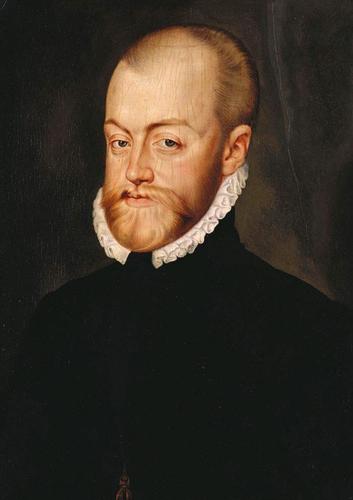-
1 of 253523 objects
Philip II, King of Spain (1527-1598) c. 1550-1600
Oil on panel | 36.8 x 26.9 x 1 cm (support, canvas/panel/stretcher external) | RCIN 403437

Spanish School, 16th century
Philip II, King of Spain (1527-1598) c. 1550-1600
-
This portrait by an unknown sixteenth century Spanish artist shows King Philip II of Spain in middle age. It is similar in type to other portraits of the King from this period in his life. While the exact date of the portrait is unknown, it was likely painted before the early1580s, after which the King was commonly shown with white hair and beard.
Phillip II ruled the vast Spanish Empire from 1554 until his death in 1598. During this forty four year reign, Spain reached the height of its power and influence, with territories on every known continent. Described as having "a smile that cut like a sword", Philip was known to be pious and distrustful, with icy self-control.
Showing the King in three-quarters, wearing a high-necked black doublet with a narrow ruff and the Order of the Golden Fleece on a black ribbon, this portrait is similar in composition to Sofonisba Anguisola's portrait of the King, dated 1565 (Museo del Prado, Madrid) and the c.1568 portrait by Alonso Sanchez Coello, now in the Kunsthistorisches Museum, Vienna.
During the sixteenth and seventeenth centuries, portraits of Spanish Habsburg Kings and Queen's conformed to a specific iconography, developed around the idea that the monarch or monarchs had two bodies – the Body Natural and the Body Politic. The Body Natural applied to the King's person, which was mortal, while the Body Politic referred to the King in his immortal state as sovereign ruler. As Kingship was believed to be ordained by God, a King was required to exemplify the qualities and virtues – Faith, Hope, Charity, Justice, Fortitude, Prudence and Temperance that were essential to Christian rule. In this portrait of Philip II, as in other portraits of this period, the King's identity as an individual has been subordinated to that of the Body Politic. He is presented as serious and watchful, wearing the simple black clothing of a priest, rather than the richly ornamented attire of a King and therefore embodies those virtues of Faith, Temperance and Prudence that are intrinsic in a Habsburg King.Provenance
Purchased by Queen Victoria in 1853 from the collection of Louis Philippe.
-
Medium and techniques
Oil on panel
Measurements
36.8 x 26.9 x 1 cm (support, canvas/panel/stretcher external)
48.4 x 38.3 x 4.1 cm (frame, external)